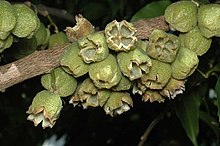Melicope rubra
Melicope rubra, commonly known as the little evodia,[2] is a species of small tree in the family Rutaceae, and is endemic to north-east Queensland. It has trifoliate leaves and pink bisexual flowers arranged on branches below the leaves.
| Little evodia | |
|---|---|
 | |
| Scientific classification | |
| Kingdom: | Plantae |
| Clade: | Tracheophytes |
| Clade: | Angiosperms |
| Clade: | Eudicots |
| Clade: | Rosids |
| Order: | Sapindales |
| Family: | Rutaceae |
| Genus: | Melicope |
| Species: | M. rubra |
| Binomial name | |
| Melicope rubra | |
| Synonyms[1] | |
| |

Description
Melicope rubra is a tree that typically grows to a height of 7 m (23 ft) with a trunk diameter of about 30 cm (12 in), but forms flowers and fruit as a shrub. The leaves are arranged in opposite pairs and are trifoliate on a petiole 20–75 mm (0.79–2.95 in) long. The leaflets are egg-shaped, 40–150 mm (1.6–5.9 in) long and 15–45 mm (0.59–1.77 in) wide, the leaflets sessile or on a petiolule up to 10 mm (0.39 in) long. The flowers are bisexual and arranged in panicles 25–65 mm (0.98–2.56 in) long on branches below the leaves. The sepals are more or less round to egg-shaped, 1.5–2.5 mm (0.059–0.098 in) long and joined at the base. The petals are pink, 5–6 mm (0.20–0.24 in) long and there are four stamens. Flowering occurs from February to June and the fruit consists of up to four follicles 20–30 mm (0.79–1.18 in) long and fused for at least half their length.[2][3][4]
Taxonomy
The little evodia was first formally described in 1900 by Carl Adolf Georg Lauterbach and Karl Moritz Schumann who gave it the name Euodia rubra and published the description in Schumann's book, Die Flora der Deutschen Schutzgebiete in der Sudsee.[5][6] In 2001, Thomas Gordon Hartley changed the name to Melicope rubra in the journal Allertonia.[4][7]
Habitat and distribution
Melicope rubra grows in forests including rainforest forest from sea level to an altitude of 850 m (2,790 ft). It is found between Shiptons Flat and Cardwell in north-eastern Queensland.[2]
Conservation status
This species is classified as of "least concern" under the Queensland Government Nature Conservation Act 1992.[8]
References
- "Melicope rubra". Australian Plant Census. Retrieved 27 July 2020.
- Hartley, Thomas G.; Wilson, Annette J.G. (ed.) (2013). Flora of Australia (Volume 26). Canberra: Australian Biological Resources Study. p. 102. Retrieved 27 July 2020.CS1 maint: extra text: authors list (link)
- "Mellicope rubra". Australian Tropical Rainforest Plants - Australian National Botanic Gardens. Retrieved 27 July 2020.
- Hartley, Thomas Gordon (February 2001). "On the Taxonomy and Biogeography of Euodia and Melicope (Rutaceae)". Allertonia. 8 (1): 211–213. Retrieved 27 July 2020.
- "Euodia rubra". APNI. Retrieved 27 July 2020.
- Schumann, Karl Moritz; Lauterbach, Carl Adolf Georg (1900). Die Flora der deutschen Schutzgebiete in der Südsee. Leipzig: Gebrüder Borntraeger. pp. 375–376. Retrieved 27 July 2020.
- "Melicope rubra". APNI. Retrieved 27 July 2020.
- "Species profile—Melicope rubra". Queensland Government Department of Environment and Science. Retrieved 27 July 2020.